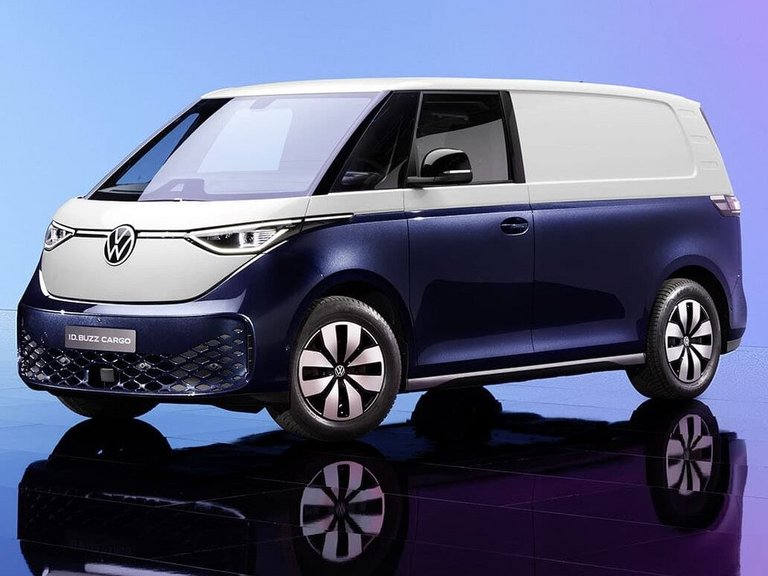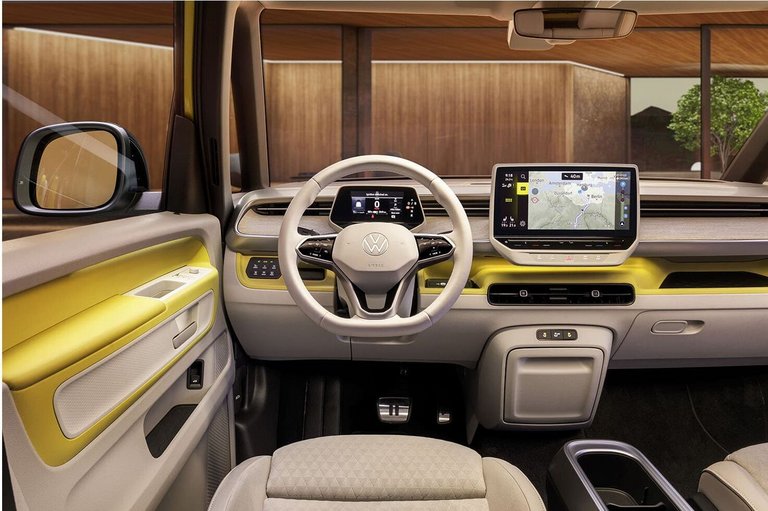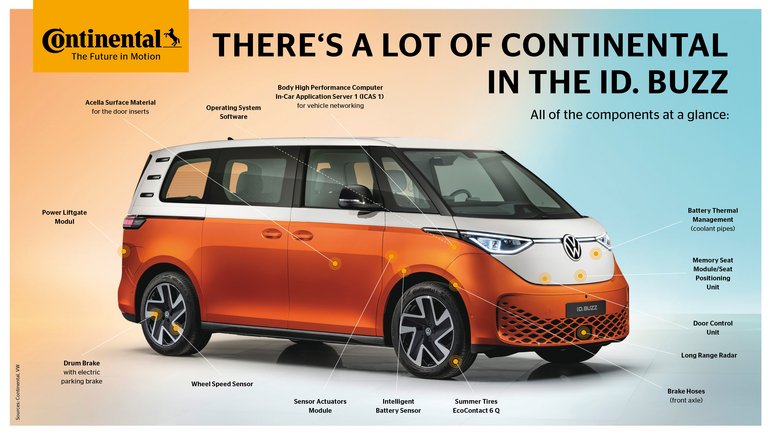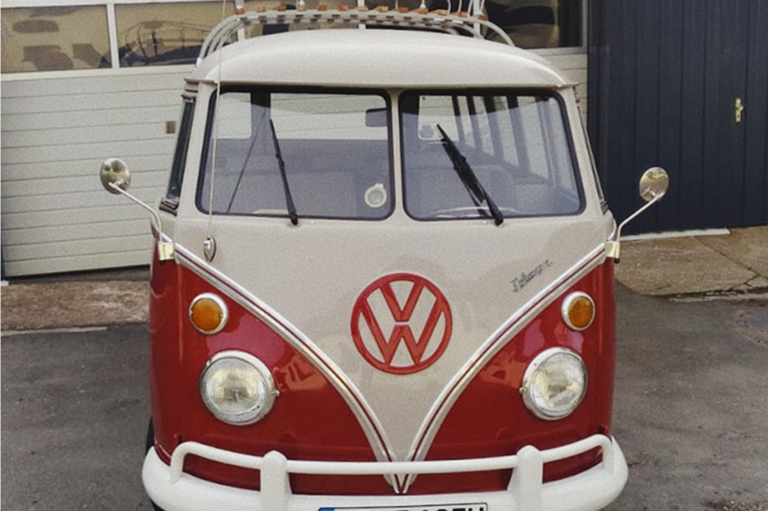The new all-electric way of vacation traveling: Continental counts among the suppliers equipping the new Volkswagen ID. Buzz minivan with a wide array of technologies.
When temperatures rise, the itch to travel gets stronger. This summer, especially, promises to unleash extraordinarily large waves of vacationers, with most pandemic-related restrictions lifted, and border closings along with mandatory testing and quarantining no longer impeding a carefree travel experience. Yet, how have the past two years affected our travel behavior? What trends are emerging and, above all, how are we going away on trips? Sustainability is playing a steadily bigger role. Many travelers focus on getting to their vacation destination in as eco-minded way as possible. The camping sector has downright boomed, and taking trips in your own country is all the trend. The longing for independence and freedom – this urge continues to play out in 2022. No car represents this compulsion for adventure and the feeling of freedom more than Volkswagen’s legendary T1 minivan, lovingly dubbed simply the VW “Bus”, “Van”, or even “Camper”. Volkswagen’s new ID. Buzz has now transported this lust for life into the age of electric mobility. A new generation is hitting the road that stands for multi-functionality, sustainability and efficiency, equipped with the newest technologies from Continental.
Recent years have enriched the travel industry with a newly coined word for a novel trend: “glamping”. Thanks to this neologism formed from “glamor” and “camping”, conventional camping has been stylized into a lifestyle, turning even the most stubborn hotel-goers into outdoor fans. All in all, four-wheeled vacations have become a popular alternative to faraway journeys, as they mean greater flexibility and independence – and not just for families. Due to the pandemic, the automobile is taking on greater importance, becoming for many people an inherent part of their travel and leisure behavior. It’s a trend that this year, too, continues unabated in Germany. A majority of people consider their car to be an essential component of their mobility and part of their personal living space. This is one of the key findings of the representative Continental Mobility Study 2022.1
Fifty-four percent of those surveyed in the study see their own car as a personal safe haven. Over half (53 percent) use a car, camper or recreational vehicle (RV) for vacation trips. And for 61 percent of the survey respondents in Germany, the comfort and security of their own vehicle on vacation trips have become even more important against the backdrop of long waiting, check-in and arrival times at airports, and canceled or in part extremely overcrowded public transportation. In each case, the overwhelming majority (70 percent) of survey respondents who indicated they had traveled during the pandemic want to continue vacationing by car, camper or RV once the pandemic is over, and possibly use them for vacations even more than before. Travelers want journeys by road to be safer and more comfortable, and also more sustainable – but at the same time well-fitting to their personal lifestyle. So, it really is the right time to take a closer look at a vehicle which for generations has best reflected the spirit of the age of mobility.
54 percent of those surveyed in the study see their own car as a personal safe haven. 54% |
53 percent use a car, camper or recreational vehicle (RV) for vacation trips. 53% |
For 61 percent the comfort and security of their own vehicle on vacation trips have become even more important. 61%
|
70 percent of survey respondents who indicated they had traveled during the pandemic want to continue vacationing by car, camper or RV once the pandemic is over, 70% |
1
This global study was conducted by the well-known market research firm infas on behalf of Continental. In Germany, for example, 1001 citizens ranging in age from 18 to 70, both male and female, were surveyed for this purpose in May 2022 to find out their personal mobility needs and wishes.
The legend of the “VW Bus” – traveling through the decades in the cult van that became an icon
In the 1950s, the legendary VW Bus stood for a new feeling of freedom, independence, and strong emotions. To this day, hardly any other car has so many fans as the VW Bus: Whether families, surfers, or businesspeople – this car is truly a timeless icon. While it can no longer be clearly traced today just where its fabled German nickname “Bulli” came from, the fact remains that the car has a fascinating history – that meanwhile goes back over 70 years already. The first model left the assembly line in Wolfsburg, Germany on March 8, 1950, and reflected at that time more than any other car the emerging culture of mobility and leisure in the post-World War II era.
The 1950s in particular witnessed vast growth in the needs and wishes for better means of transport, driving VW to develop this new type of vehicle. What set this first-generation “T1” (T for “Transporter”) apart was the versatility of use options it offered: Whether for transporting goods, or as a refrigerated vehicle, ambulance, mobile kiosk or construction site vehicle with crane attachment, this VW Bus was a real all-round talent – precisely what made it so popular. And yet, in the long term it was the vehicle’s role in shaping people’s leisure and travel activities that molded the onward development of the VW Bus. This quickly led to an expanded portfolio of features and fitments for private use, including extension elements for camping, for instance. After the destructive years of war, a longing for mobility and traveling rose, and the T1 served these desires perfectly.
Volkswagen’s second-generation Transporter, dubbed the T2, hit the market in 1967. Larger overall and fitted with an improved chassis, this next generation of the legendary VW Bus enjoyed wide popularity not only in its home country Germany: One in three VW buses of the T2 generation found an owner in the United States. As the 1970s came to a close, the VW bus took on not only some technical innovations, but a new look as well. The T3 was significantly bigger than its two predecessors, and offered more stowage space. While the T1 and T2 were originally equipped with the same engine as the Volkswagen Beetle, the VW Bus introduced in May 1979 was the first Transporter model built by Volkswagen with its own dedicated engine. Families in particular quickly appreciated the spaciously designed VW Bus, which enjoyed widespread popularity for leisure activities. The automaker again responded quickly to meet the needs and wishes of non-commercial owners: The T3 “Multivan” launched in 1985 as a versatile large-capacity passenger car set whole new standards in terms of vacation experience. Offering enough space for overnight sleeping, it became the perfect companion for journeys around the globe. Even today, the T3 is still a highly popular model for people who want to experience the real road-trip feeling of the 1970s.
Time for a new generation
In 1990, Volkswagen introduced a completely new generation of Transporters. Equipped with front-wheel drive and a front-engine configuration, the T4 offered a number of technical innovations. This model likewise offered various features, extras and extension fitments, particularly for private use.
In the early 2000s, Volkswagen took things one step further with its utility vehicles by introducing the T5, marking the first time that VW offered a Transporter with three different roof heights. Designed with significantly more stowage space, this innovative version followed the general trend towards luxury-limo people carrier. After a facelift of the T5 in 2009, further redesigning ultimately led to the T6 Bus. While this new generation didn’t feature any distinguishing visible modifications, its improved engine, smarter assistance systems and complex infotainment program reflected the spirit of the times and driver expectations of the 2000s. With the age of digitalization steadily advancing at an ever faster pace, Volkswagen was ultimately inspired to bring to market yet another update already in 2019. The iconic model gleamed anew with novel dashboard and, for the first time, fully digital instrumentation.
Taking it to a whole new level
The very first all-electric ID. Buzz from Volkswagen that rolled off the assembly line in early June combines the demands and aspirations of safe and comfortable yet sustainable mobility. Even if much has changed internally, the exterior looks of the new VW Bus are strikingly similar to the T1 Bus, evoking feelings of nostalgia. Fully state-of-the-art in its technology, this car facilitates everyday routines while turning driving into whole new experience. Got your hands full when you come to pack the trunk? The electric tailgate can be opened with simple movement of your foot. And the individually adjustable seats let you set your lighting while underway to create a fittingly enjoyable ambience. But that’s not all the VW Bus of the future is expected to do: Achieving sustainability for a climate-conscious future was just as important in developing the ID. Buzz as ensuring a comfortable driving experience. Volkswagen has once again succeeded in shaping the art of traveling for a whole new generation. And it’s precisely along this road to the future of mobility that Continental has been supporting the automaker – and doing so right from the start.
Continental gets the VW Bus rolling
The fact that the new ID. Buzz is not only produced in Hanover, Germany, but is also equipped with technologies from Continental, is not the only connection Continental has to the iconic VW Bus. The very first models of the T1 rolling off the assembly line in 1950 also already contained installed components from Continental and what today are Continental subsidiaries. These included hoses, buffers, seals and gaskets, fan belts and surface materials. The years that followed saw Continental develop a wide range of technologies for drive shafts, hydraulic four-wheel brakes and fuel meters for use in the T1 models. So it wasn’t just the high-performance tires from Continental that helped make the original VW Bus so successful.
Continental maintained a close relationship to the versatile T1 from Volkswagen – not only as a technology partner, but also in its own vehicle fleet. Continental used these vehicles for example to make promotional films, or deployed them as support cars for racing events, or as test and sales vehicles.
A high-performance ride into the future of electric mobility
Continental supplies various high-performance components for the ID. Buzz that Continental has developed itself, such as its In-Car Application Server 1 (ICAS 1) which, as a fully networked server, acts as the central data hub in the vehicle and the connection point between the ID. Buzz and the digital world. The central high-performance computer which Continental developed in close collaboration with its subsidiary Elektrobit (who also supplies the operating system) enables new software functions as well as safety and security updates to be installed in the vehicle via wireless connection. The ICAS 1 also makes functions such as range-optimized route planning and locating charging stations available to the electric VW Bus, all of which make “electric” journeys simpler and more convenient and comfortable.
In addition, Continental developed what is called the Plug and Charge function for the ICAS 1. When the charging cable is plugged in, the server’s software supports authentication of the registered vehicle at supported charging stations, and automatically manages the charging operation.
Continental also injects its in-house technology expertise into the thermal management, tires, and interior materials of the ID. Buzz. For example, new Volkswagen ID. Buzz’s leaving the assembly line are fitted with Continental’s EcoContact 6 Q summer tires on 19- and 20-inch diameter wheel rims. These tires offer particularly low rolling resistance, which saves energy and lends the e-van the greatest possible range between charging cycles. Equipping the vehicle with ContiSeal technology meets the requirements of the ID. Buzz in a special way, reliably sealing its tires in the event the tread ply is pierced by objects of up to 5-millimeter diameter, and thereby preventing some 90 percent of the tire damage that would otherwise occur.
Electric vehicles pose particularly high demands on thermal management functions, as multiple cooling circuits are maintained for the batteries in order to achieve longer range and long battery service life. Continental supplies, among other components, the battery sensors and coolant lines for the ID. Buzz. When selecting and compiling the sustainable materials installed in the vehicle interior, Acella PVC artificial leather is used for the door inserts from Continental.
The Brocken meets the Bus
Even Germany’s Brocken can’t stop the fascination for the iconic VW Bus: On this highest mountain in Northern Germany and popular tourist attraction, we meet Daniel Steinhoff, operator of the legendary Brockenhotel in the Harz Mountains. His love for the VW Bus runs through the family, as his father maintained a T3 Bus in his vehicle fleet already in the early 1990s to keep his popular tourist destination well supplied. Won over by the vehicle’s quality, even in bad weather conditions during the winter months, the subsequent years saw T4, T5 and T6 models acquired to serve the hotel as well. The Steinhoff family also count among the first owners to use the T4 natural gas buses in their business.
The Brockenhotel’s vehicle fleet currently has three T6 Buses with double cab, three T6 Minibuses, and Steinhoff himself drives a T6 Multivan as his private vehicle – all equipped with 4MOTION all-wheel drive. Yet, he has a soft spot for even the older models, and today owns an original T1 Bus and a T2 Bus. But these iconic, classic VW Buses were not easy to come by: only after long searching did he fulfill his wish in 2016 and 2017 to acquire these beloved vintage cars.
"The ID. Buzz would of course interest us, especially because of its sustainability"
Daniel Steinhoff, operator of the legendary Brockenhotel in the Harz Mountains
Asked whether the ID. Buzz could be an option for him, he answers, “The ID. Buzz would of course interest us, especially because of its sustainability. For me personally, it would be exciting to see how it behaves in winter, when it’s already needed early in the morning up there in the cold, and evenings after hours when you have to drive back down to the town of Schierke.”
He, too, has certainly noticed the change in travel behavior among tourists. The Brocken sees peak-season crowds particularly on weekends and during school vacation periods. No wonder, as the Harz Mountains offer a unique natural environment and a wide range of destinations for outings – like the popular hotel at the Brocken summit. And that’s what the VW Bus and this special location at an elevation of 1,141 meters share in common: their iconic status and unique appeal.
Daniel Steinhoff’s two vintage T models at the Wurmberg Vintage Car Rally in Germany’s Harz Mountains:
A sure-fire success for the future
It’s not the destination – it’s the journey. No other car stands more for this motto than the legendary Transporter from Volkswagen: the VW Bus. While the models have continuously changed over the decades, the fascination always remains the same. Volkswagen seeks to expand its clientele reach with the ID. Buzz and, overall, increase the volume of electric mobility. For this reason, additional variants are planned for the future, including models fitted with a smaller battery pack and with all-wheel drive. A pickup version is likewise not ruled out.
Recent years have shown us how quickly our daily routines can be changed by external circumstances, thereby influencing our form of mobility, too. Our travel behavior, how we address the issue of sustainability, our relationship with the automobile, even our driving in itself: everything is continuously changing. The new ID. Buzz demonstrates all this in a particularly special way, as it unites an innovative eye for the future with a nostalgic connection to its unique, iconic past. No matter where the journey leads: A range of over 420 km per charge will in any case take you a long way forward into a new world of mobility.














